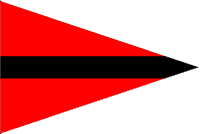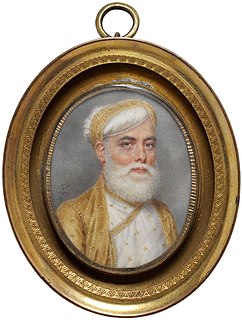Related Research Articles

Akbar II, , also known as Akbar Shah II, was the nineteenth Mughal emperor of India. He reigned from 1806 to 1837. He was the second son of Shah Alam II and the father of Bahadur Shah II.

Nawab, also spelt Nawaab, Navaab, Navab, Nowab, Nabob, Nawaabshah, Nawabshah or Nobab, is a Royal title indicating a sovereign ruler, often of a South Asian state, in many ways comparable to the western titles of King. The relationship of a Nawab to the Emperor of India has been compared to that of the Kings of Saxony to the German Emperor. In earlier times the title was ratified and bestowed by the reigning Mughal emperor to semi-autonomous Muslim rulers of subdivisions or princely states in the Indian subcontinent loyal to the Mughal Empire i.e. Nawabs of Bengal. The title is common among Muslim rulers of South Asia as an equivalent to the title Maharaja.

Ahmad Shah Bahadur, also known as Mirza Ahmad Shah or Mujahid-ud-Din Ahmad Shah Ghazi was fourteenth Mughal Emperor he was born to Emperor Muhammad Shah. He succeeded his father to the throne in 1748 at the age of 22. When Ahmed Shah Bahadur came to power, the Mughal Empire was collapsing. Furthermore, his administrative weaknesses eventually led to the rise of the usurping Imad-ul-Mulk.

Shah Alam II, born as Ali Gohar or Ali Gauhar was the seventeenth Mughal Emperor and the son of Alamgir II. Shah Alam II became the emperor of a crumbling Mughal empire. His power was so depleted during his reign that it led to a saying in the Persian language, Sultanat-e-Shah Alam, Az Dilli ta Palam, meaning, 'The empire of Shah Alam is from Delhi to Palam', Palam being a suburb of Delhi.

Varanasi division is an administrative geographical unit of Uttar Pradesh state of India. Varanasi is the administrative headquarters of the division. Currently (2018), the division consists of districts of Varanasi, Chandauli, Ghazipur, and Jaunpur and is loosely equivalent to the Benares State.

Ghazipur district is a district of Uttar Pradesh state in northern India. The city of Ghazipur is the district headquarters. The district is part of Varanasi Division. The region of Ghazipur is famous mainly for the production of its unique rose-scented Spray called Gulab Jal, and for the tomb of the Governor General of British India, Lord Cornwallis, who died here. His tomb is situated in Western part of City, and is conserved by Archaeological Survey of India.

Benares or Banaras State was a kingdom and later princely state in what is today Uttar Pradesh, India. On 15 October 1948 Benares' last ruler signed the accession to the Indian Union.

Baba Baghel Singh was a military general in the Punjab region in the northern part of the Indian subcontinent in the 18th century. He rose to prominence in the area around Sutlej and Yamuna. Singh joined the Singh Krora Misl, one of the misls during Sikh Confederacy. In 1765, Singh became the leader of the misl.

Muhammad Ali Khan Wallajah, or Muhammed Ali, Wallajah, was the Nawab of Arcot in India and an ally of the British East India Company. Muhammad Ali Khan Wallajah was born to Anwaruddin Muhammed Khan, by his second wife, Fakhr un-nisa Begum Sahiba, a niece of Sayyid Ali Khan Safavi ul-Mosawi of Persia, sometime Naib suba of Trichonopoly, on 7 July 1717 at Delhi. Muhammed Ali Khan Wallajah the Nawab of Arcot often referred to himself as the Subedar of the Carnatic in his letters and correspondence with the then Mughal Emperor Shah Alam II.

The Imperial Legislative Council was a legislature for British India from 1861 to 1947. It succeeded the Council of the Governor-General of India, and was succeeded by the Constituent Assembly of India and after 1950, was succeeded by Parliament of India.

The Darbhanga Raj, also known as Raj Darbhanga and the Khandwala dynasty, was a Brahmin dynasty and the rulers of territories, not all contiguous, that were part of the Mithila region, now divided between India and Nepal.

The Narayan dynasty was the ruling family of Benares. After its liberation from Awadh, independence (swaraj) was established in Benares by Maharaja Balwant Narayan Singh in the 18th century. Since then, the family has ruled Benares. In 1911, Benares became a full-fledged princely state of British India and the Narayan dynasty ruled it as British vassals until they acceded to independent India in 1947.

The Zamindars of Bengal were the ruling class, in the Bengal region, in the eastern part of the Indian subcontinent, which consists of territories East Bengal which is now Bangladesh and West Bengal. The Nawabs of Bengal ruled the area under the Mughal Empire from 1717 to 1880. Murshid Quli Jafar Khan governed the area, through his feudal chiefs, the zamindars originally known as bhumipatis, which mirrored the European system of serfdom. The zamindars dominated most of the villages in Bengal. The Baro-Bhuyan occupied the region west of the Kayastha in the south bank of the Brahmaputra river, and west of the Kayastha Chutia kingdom in the north bank, and were prevalent in the area since 1498. The Gain family of Bengal were prominent zamindars who owned large amounts of land and built their ancestral castles in Dhanyakuria, now owned by the state-government. Thakur Hariwansh Narayan Singh of khilwat near Hajipur, Bihar ruled over an area of 22,445 km2 but later the more than 2/3 part of total land is occupied by East India Company. The Dutta Choudhury family of Western Howrah region were prominent bhumipatis who owned the entire Muzaffarpur pargana.
Events in the year 1707 in India.

Sir Randhir Singh Sahib Bahadur was the ruling Raja of the princely state of Kapurthala in the British Empire of India from 1852 until his death in 1870.

Rafa'at wa Awal-i-Martabat Maharaja Sri Chait Singh Sahib Bahadur commonly known as Chait Singh was a ruler of Kingdom of Benares in northern India.
Maharaja Mahip Narayan Singh Saheb Bahadur succeeded the throne of Benares on 14 September 1781. He became the ruler but under the terms of the company, which were that he should serve to dispense justice within his domains and make an annual contribution of 40 lakhs. He continued his family tradition of tussles with Britishers, who in turn labeled him incapable of governing because he refused to levy any taxes on farmers and thus refused to assist Britishers in draining wealth from India towards England, therefore on 27 October 1794, under a formal agreement the four sarkars, or revenue districts, held by the Maharaja were transferred to the direct rule of the Company administration, leaving only the family domains under the rule of the Maharaja; in return Mahip Narayan Singh received 1 lakh per year in compensation and any surplus revenue of the sarkars. Mahip Narayan Singh died barely a year later and was succeeded by his eldest son, Rafa'at wa Awal-i-Martabat Maharaja Sri Udit Narayan Singh Sahib Bahadur.